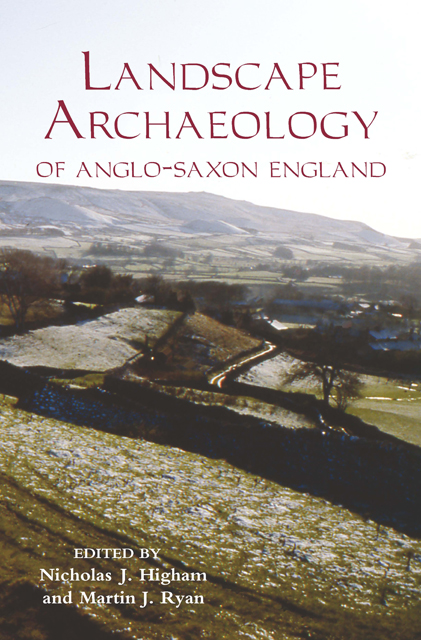Book contents
- Frontmatter
- Contents
- List of Illustrations
- Contributors
- Acknowledgements
- Abbreviations
- 1 The Landscape Archaeology of Anglo-Saxon England: An Introduction
- 2 Barriers to Knowledge: Coppicing and Landscape Usage in the Anglo-Saxon Economy
- 3 Landscape Change during the ‘Long Eighth Century’ in Southern England
- 4 Population Ecology and Multiple Estate Formation: The Evidence from Eastern Kent
- 5 Exploring Black Holes: Recent Investigations in Currently Occupied Rural Settlements in Eastern England
- 6 Medieval Field Systems and Settlement Nucleation: Common or Separate Origins?
- 7 The Environmental Contexts of Anglo-Saxon Settlement
- 8 Calendar Illustration in Anglo-Saxon England: Realities and Fictions of the Anglo-Saxon Landscape
- 9 The Anglo-Saxon Plough: A Detail of the Wheels
- 10 ‘In the Sweat of thy Brow Shalt thou eat Bread’: Cereals and Cereal Production in the Anglo-Saxon Landscape
- 11 The Early Christian Landscape of East Anglia
- 12 The Landscape and Economy of the Anglo-Saxon Coast: New Archaeological Evidence
- Index
3 - Landscape Change during the ‘Long Eighth Century’ in Southern England
Published online by Cambridge University Press: 16 February 2023
- Frontmatter
- Contents
- List of Illustrations
- Contributors
- Acknowledgements
- Abbreviations
- 1 The Landscape Archaeology of Anglo-Saxon England: An Introduction
- 2 Barriers to Knowledge: Coppicing and Landscape Usage in the Anglo-Saxon Economy
- 3 Landscape Change during the ‘Long Eighth Century’ in Southern England
- 4 Population Ecology and Multiple Estate Formation: The Evidence from Eastern Kent
- 5 Exploring Black Holes: Recent Investigations in Currently Occupied Rural Settlements in Eastern England
- 6 Medieval Field Systems and Settlement Nucleation: Common or Separate Origins?
- 7 The Environmental Contexts of Anglo-Saxon Settlement
- 8 Calendar Illustration in Anglo-Saxon England: Realities and Fictions of the Anglo-Saxon Landscape
- 9 The Anglo-Saxon Plough: A Detail of the Wheels
- 10 ‘In the Sweat of thy Brow Shalt thou eat Bread’: Cereals and Cereal Production in the Anglo-Saxon Landscape
- 11 The Early Christian Landscape of East Anglia
- 12 The Landscape and Economy of the Anglo-Saxon Coast: New Archaeological Evidence
- Index
Summary
Introduction: Challenging the Midland-Centric Focus of Medieval Landscape Studies
England's is a rich and varied landscape. A fifteenth-century traveller making the journey from Exeter in the South-West, to Oxford in the South Midlands, and then across to Ipswich in East Anglia would have witnessed a wide variety of countrysides, with scattered farmsteads and small hamlets set within predominantly enclosed fields around Exeter, the ‘champion’ countryside of villages surrounded by vast open fields in the Midlands, and another area of dispersed settlement and a predominantly enclosed fieldscape across in the southern part of East Anglia (Fig. 3.1). The origins of this broad tripartite division in landscape character, which was first described by the antiquarian John Leland in the mid sixteenth century, have been much debated, with old ideas that villages and open fields were brought across the North Sea by Early Anglo-Saxon migrants being rejected in favour of current views that they were an indigenous development of the mid ninth to twelfth centuries.
A wide variety of explanations have been put forward as to why this central zone of England – which Brian Roberts and Stuart Wrathmell have called the ‘central province’ – saw the development of champion countryside characterized by settlement nucleation and open fields. These include rising population and the restructuring of resources within landed estates which, in the context of an expanding economy and the increased burdens that an emerging English state placed upon landowners, encouraged the reorganization of agriculture in order to increase production. In a number of recent studies, there is a more or less explicit assumption that the central zone saw the development of villages and open fields because this was the most socially and economically advanced region, with areas to the east and west being somewhat less well developed (Fig. 3.2). Della Hooke, for example, suggests that ‘if the dominant land use of such areas [of dispersed settlement] was pastoralism, and there was an abundance of woodland and waste, there would be little incentive for massive reorganization of earlier settlement and field systems’.
- Type
- Chapter
- Information
- The Landscape Archaeology of Anglo-Saxon England , pp. 39 - 64Publisher: Boydell & BrewerPrint publication year: 2010
- 6
- Cited by



